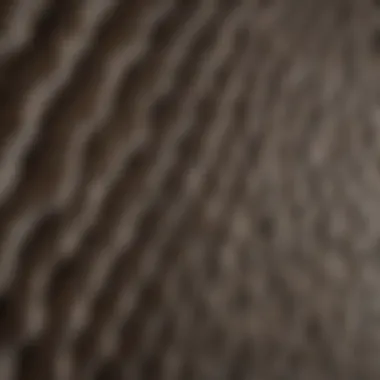Expert Guide for Crafting a Noise-Reducing Enclosure: Step-by-Step Instructions


This article delves deep into the process of creating a soundproof box, offering valuable insights and detailed instructions to assist individuals in effectively reducing noise levels in various settings. From essential concepts to practical tips, this guide aims to equip readers with the knowledge needed to construct a soundproof enclosure successfully.
Types of Materials for Soundproofing
Soundproofing materials play a crucial role in creating an effective soundproof box. Options such as acoustic foam, mass loaded vinyl, and soundproof curtains offer varying levels of sound absorption. Understanding the characteristics and applications of each material is vital in selecting the most suitable option for your specific needs.
Design Considerations and Acoustic Principles
Incorporating key design elements and adhering to fundamental acoustic principles are essential in ensuring the efficiency of a soundproof box. Factors like box shape, sealing techniques, and airflow dynamics significantly impact the overall soundproofing effectiveness. By mastering these design considerations, individuals can enhance the ability of their soundproof box to attenuate unwanted noise.
Assembly and Installation Techniques
Guiding readers through the step-by-step process of assembling and installing a soundproof box, this section covers everything from preparing the materials to sealing gaps effectively. Each stage of the construction is meticulously detailed, providing practical insights and expert tips to facilitate a seamless and successful build.
Testing and Optimization Strategies
Once the soundproof box is constructed, testing its effectiveness and optimizing its performance become crucial steps. From conducting sound tests to identifying and addressing potential weak points, this section offers a comprehensive overview of how to fine-tune a soundproof enclosure for optimal noise reduction.
Conclusion
Introduction
In this article, we delve into the intricacies of constructing a soundproof box, providing a thorough guide for individuals seeking to mitigate noise disturbances in various environments. By following the step-by-step instructions and incorporating the invaluable tips shared here, readers can effectively minimize noise levels within confined spaces. Soundproof boxes serve as a versatile solution for noise reduction, offering a practical way to enhance the acoustic environment.
Understanding the Need for a Soundproof Box
Assessing Noise-related Issues
Noise-related issues are a common concern in residential, commercial, and industrial settings, where unwanted sounds can disrupt activities and cause discomfort. Assessing these issues involves identifying the sources of noise pollution, evaluating their intensity, and determining the best methods for soundproofing. This meticulous process ensures that the soundproof box effectively addresses the specific noise challenges faced by the individual or establishment. By analyzing noise-related issues comprehensively, one can tailor the soundproofing solutions to achieve optimal results.
Identifying the Benefits of Soundproofing
The benefits of soundproofing extend beyond mere noise reduction, encompassing improved privacy, enhanced concentration, and heightened comfort levels. Soundproofing minimizes the transmission of sound waves, creating a more serene and conducive environment for various activities. Whether used in a home office, recording studio, or any other space, soundproof boxes offer a sanctuary free from external disturbances, fostering productivity and tranquility.
Applications of Soundproof Boxes
Soundproof boxes find diverse applications across industries such as music production, home theaters, and telecommunication facilities. These boxes are instrumental in containing sound emissions, preventing external noises from infiltrating sensitive equipment or spaces. By encapsulating sound within a controlled environment, soundproof boxes safeguard the integrity of audio recordings, protect equipment from environmental factors, and uphold the acoustic integrity of specialised spaces.


Overview of the Soundproofing Process
Basic Principles of Soundproofing
At the core of soundproofing lie fundamental principles that govern the transmission, absorption, and reflection of sound waves. Understanding these principles is crucial for designing effective soundproofing strategies that address specific noise challenges. By leveraging the principles of mass, damping, and decoupling, individuals can construct soundproof boxes that exhibit optimal acoustic insulation, minimizing the intrusion of unwanted noise.
Materials Required for Soundproofing
Selecting the right materials is essential for the success of any soundproofing endeavor. From acoustic foam panels to sound barrier mats, a range of materials can be employed to enhance the sound insulation properties of a box. Each material offers unique acoustic characteristics, such as absorption coefficients and density ratings, which contribute to the overall efficacy of the soundproofing solution.
Factors to Consider Before Building
Before embarking on the construction of a soundproof box, several factors must be taken into account to ensure its functionality and durability. Considerations such as space constraints, ventilation requirements, and aesthetic preferences play a pivotal role in designing a box that meets the specific needs of the user. By meticulously assessing these factors, individuals can tailor their soundproofing approach to create a customized solution that effectively addresses their unique acoustic challenges.
Preparation Stage
In the journey of creating a soundproof box, the Preparation Stage plays a crucial role in ensuring the success of the project. This preliminary phase sets the foundation for the construction process by organizing all the necessary tools and materials and establishing an efficient workspace. Focusing on this aspect in the article provides readers with a clear roadmap to follow, emphasizing the importance of thorough preparation before diving into the construction phase.
Gathering Necessary Tools and Materials
List of Essential Tools
When embarking on the task of building a soundproof box, having the right tools is essential for efficiency and precision. The List of Essential Tools includes items such as measuring tape, saw, drill, screws, and other carpentry tools required for accurate and smooth construction. Each tool serves a specific purpose in the process, ensuring that every step is carried out with accuracy and attention to detail. The efficiency and quality of the construction heavily rely on the presence and proper utilization of these essential tools.
Selection of Soundproofing Materials
The selection of soundproofing materials is a critical aspect that directly impacts the effectiveness of the final soundproof box. Materials like soundproofing foam, acoustic panels, weatherstripping tapes, and mass loaded vinyl are popular choices known for their sound-absorbing and insulation properties. Each material has unique characteristics that contribute to noise reduction, thermal insulation, and structural reinforcement, making them valuable assets in soundproofing applications. Understanding the advantages and disadvantages of different soundproofing materials is key to making informed decisions in selecting the most appropriate ones for the specific soundproof box being constructed.
Setting Up a Workspace
In the realm of soundproof box construction, creating an optimized workspace is essential for ensuring smooth progress and a well-executed final product. Proper workspace setup involves considerations such as ensuring adequate ventilation and organizing the work area for maximum efficiency. Adequate ventilation is crucial to maintain a healthy work environment, especially when using adhesives or materials with fumes. Organizing the work area with a designated space for tools, materials, and work-in-progress components helps streamline the construction process, reducing the potential for errors and enhancing productivity.
Ensuring Adequate Ventilation
Adequate ventilation in the workspace is vital for the health and safety of the individuals involved in the construction of a soundproof box. Proper airflow helps dissipate any harmful vapors or particles released during the construction process, promoting a clean and breathable environment. Ventilation also aids in regulating temperature and humidity levels, creating a comfortable and optimal setting for focused work.
Organizing Work Area


Organizing the work area is not just about tidiness; it is a strategy to boost efficiency and minimize disruptions during the construction process. A well-organized workspace ensures that tools and materials are easily accessible when needed, reducing time wastage and simplifying complex construction tasks. By maintaining a structured work area, individuals can work methodically, stay focused, and complete each step of building the soundproof box with precision and accuracy.
Construction Process
In the realm of creating a soundproof box, the Construction Process stands out as a vital stage that dictates the efficacy of soundproofing efforts. This section delves deep into the meticulous process of constructing a soundproof box, focusing on key elements that contribute to optimal soundproofing outcomes. Understanding the nuances of the Construction Process is crucial for achieving desired results and ensuring soundproofing success.
Building the Frame
Cutting and Assembling Wood
When it comes to building the frame of a soundproof box, the task of Cutting and Assembling Wood takes center stage due to its significant impact on the overall structure's robustness and durability. The precision and quality of wood cutting and assembly directly influence the effectiveness of soundproofing by creating a sturdy foundation for soundproofing materials. Opting for high-quality wood that offers optimal strength and acoustical properties is essential for crafting a reliable soundproof box. The meticulous process of cutting and assembling wood ensures seamless integration of components, minimizing sound leaks and enhancing soundproofing performance.
Securing Joints for Stability
Securing Joints for Stability plays a critical role in fortifying the structural integrity of a soundproof box. By carefully fastening joints using appropriate techniques and materials, stability is enhanced, minimizing vibrations and potential weak points that could compromise soundproofing effectiveness. The meticulous attention to detail in securing joints ensures that the box remains solid and resistant to external noise disturbances, enhancing its overall soundproofing capabilities. While securing joints requires precision and care, the end result is a sturdy and reliable structure that forms the cornerstone of an effective soundproof box.
Soundproofing Techniques
Installing Soundproofing Insulation
The installation of soundproofing insulation is a pivotal aspect of the soundproofing process, significantly impacting the box's acoustical performance. Selecting the appropriate type of insulation and ensuring proper installation is paramount for effectively reducing noise infiltration. Soundproofing insulation works by absorbing and dampening sound waves, preventing them from escaping or entering the enclosed space. This critical step enhances the box's ability to create a controlled acoustic environment, conducive to the intended purpose of soundproofing.
Sealing Gaps and Cracks
Sealing Gaps and Cracks is a fundamental technique in soundproofing that aims to eliminate potential avenues for sound leakage. By meticulously sealing any gaps or cracks in the box's structure, air-tightness is achieved, minimizing sound transmission and enhancing overall soundproofing efficiency. The strategic application of sealants and acoustic materials ensures that the box remains impermeable to unwanted noise, creating a secure and insulated environment ideal for soundproofing purposes.
Finalizing the Box Structure
Adding Finishing Touches
Adding Finishing Touches to the soundproof box provides both functional and aesthetic benefits, enhancing its overall performance and visual appeal. From applying protective coatings to refining surface textures, these finishing touches not only protect the box from external elements but also contribute to soundproofing efficiency. Attention to detail in finishing touches underscores a commitment to quality and craftsmanship, elevating the box's design while ensuring long-lasting durability.
Testing Soundproofing Effectiveness
Testing Soundproofing Effectiveness is a crucial step in validating the soundproof box's performance and identifying any potential areas of improvement. Through systematic testing and analysis, the efficacy of soundproofing measures can be assessed, leading to refinements that optimize soundproofing capabilities. By subjecting the box to rigorous sound tests and assessments, the effectiveness of soundproofing techniques is verified, ensuring that the box meets the desired standards of noise reduction and isolation.
Optimization and Maintenance


Optimization and maintenance play a crucial role in ensuring the longevity and effectiveness of a soundproof box. In this article, we will delve deep into specific elements, benefits, and essential considerations regarding optimization and maintenance. By properly fine-tuning and maintaining your soundproof box, you can enhance its performance and durability, ultimately creating a more peaceful environment for your activities.
Fine-tuning Soundproofing
Adjusting Insulation Layers
Adjusting insulation layers is a key aspect of optimizing soundproofing within your box. This process allows you to tailor the thickness and density of the insulation to dampen specific frequencies of noise effectively. The resilience and sound-absorbing properties of the insulation material are vital in minimizing sound transmission. This meticulous adjustment not only improves soundproofing but also contributes to energy efficiency by reducing heat transfer through the box. In this article, we emphasize the precision and attention to detail required when adjusting insulation layers to achieve the desired level of sound insulation.
Enhancing Sealing Techniques
Enhancing sealing techniques is another essential component of soundproofing optimization and maintenance. Proper sealing of gaps and joints prevents sound leakage, ensuring that the box remains acoustically isolated. The key characteristic of enhancing sealing techniques lies in the thoroughness of sealing every potential escape point for sound waves. By focusing on airtight seals, you can significantly improve the soundproofing effectiveness of your box. However, it is crucial to balance the sealing process to avoid overcompensating and causing structural damage. This article highlights the importance of enhancing sealing techniques to create a well-insulated and quiet environment within the soundproof box.
Regular Maintenance Practices
Cleaning and Inspecting Materials
Regular cleaning and inspection of soundproofing materials are indispensable maintenance practices for preserving the functionality of the soundproof box. Cleaning removes dust, dirt, and contaminants that may compromise the soundproofing properties of the materials. Inspecting materials allows you to detect early signs of wear, tear, or damage, enabling timely repairs or replacements to uphold the box's performance. The key characteristic of cleaning and inspecting materials is to maintain cleanliness and structural integrity, promoting the longevity of the soundproof box. By implementing these practices, you can ensure that your soundproofing materials continue to perform optimally over time.
Ensuring Longevity of Soundproofing
Ensuring the longevity of soundproofing involves proactive measures to safeguard the materials and structural integrity of the box. By implementing proper maintenance routines and preemptive repairs, you can prevent costly damage and deterioration. The key characteristic of ensuring longevity lies in developing a maintenance schedule and adhering to best practices for preserving soundproofing materials. While there may be some initial effort involved, the long-term benefits of extended functionality and performance far outweigh the maintenance investment. This article emphasizes the significance of ensuring the longevity of soundproofing to maximize the lifespan and efficacy of your soundproof box.
Conclusion
In this comprehensive guide on building a soundproof box, we have delved into the crucial aspects and intricacies of soundproofing techniques. Understanding the importance of soundproofing in various scenarios is paramount, whether it's for recording studios, home theaters, or noisy work environments. Soundproof boxes serve as vital components in maintaining a peaceful and distraction-free space, enhancing productivity and overall well-being. By following the step-by-step instructions provided in this guide, individuals can effectively reduce noise levels and create a harmonious environment.
Summary of Key Steps
Achievements in Soundproofing
Achievements in soundproofing play a pivotal role in ensuring optimal noise reduction within a confined space. By integrating quality soundproofing materials and techniques, such as acoustic foam panels, mass-loaded vinyl, and resilient channels, a soundproof box can achieve outstanding sound insulation properties. The key characteristic of achievements in soundproofing lies in their ability to significantly diminish noise transmission, thus promoting a quieter and more conducive environment for various activities. While the installation of soundproofing materials can enhance acoustics, there may be limitations in completely eradicating all sound sources. However, with proper planning and implementation, achievements in soundproofing can greatly enhance the soundproofing effectiveness of the box.
Future Applications
Looking towards the future, the applications of soundproof boxes are vast and diverse. As technological advancements continue to evolve, the need for soundproofing solutions becomes increasingly essential across different industries. Future applications of soundproof boxes may extend to emerging fields like virtual reality gaming rooms, home recording studios, or even quiet zones in open office spaces. The unique feature of future applications lies in their adaptability and versatility in catering to ever-changing noise control requirements. While there are challenges in addressing specific noise frequencies in some environments, the innovation in soundproofing materials and construction methods paves the way for expanded uses of soundproof boxes in the future.
Final Thoughts
Importance of Soundproofing
The significance of soundproofing cannot be overstated when it comes to creating a peaceful and functional living or working environment. Effective soundproofing solutions contribute towards reducing stress levels, improving concentration, and enhancing overall quality of life. The key characteristic of soundproofing lies in its ability to create a barrier against unwanted noise intrusion, fostering a serene atmosphere for activities that require concentration or relaxation. While soundproofing may require initial investment and thoughtful planning, the long-term benefits in terms of improved acoustics and comfort make it a worthwhile endeavor.
Enhancing Living or Working Spaces
Enhancing living or working spaces through soundproofing techniques elevates the quality of one's daily experiences. By implementing soundproofing measures such as installing soundproofing insulation, sealing gaps, and using soundproof materials, individuals can transform their spaces into sanctuaries of tranquility. The unique feature of enhancing living or working spaces through soundproofing lies in the transformation of noisy, hectic environments into peaceful retreats that promote productivity and relaxation. While certain challenges such as proper ventilation and maintenance may arise, the advantages of enhanced acoustics and improved overall well-being outweigh any potential drawbacks.







